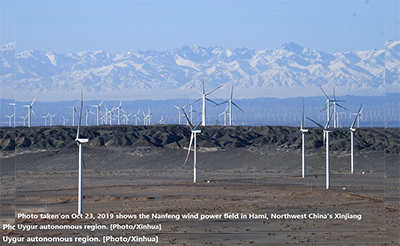


BEIJING -- China on Wednesday released a white paper to document the country's progress in mitigating climate change, and to share its experience and approaches with the rest of the international community.
The white paper, titled "Responding to Climate Change: China's Policies and Actions," was released by the State Council Information Office.
Besides the preface and conclusion, the white paper consists of four parts: "China's New Responses to Climate Change," "Implementing a National Strategy of Actively Responding to Climate Change," "Significant Changes in China's Response to Climate Change" and "Building a Fair and Rational Global Climate Governance System for Win-Win Results."

1.White paper lists China's achievements in responding to climate change

China has coordinated economic development with pollution and emission reduction, pushed forward revolutions in energy production and consumption, driven low-carbon industrial transition, increased carbon sink capacity of ecosystems, and promoted green and low carbon lifestyles, said the white paper.
The following are highlights of the country's achievements in this respect revealed in the white paper:
-- China's carbon intensity has decreased significantly.
The country's carbon intensity in 2020 was 18.8 percent lower than that in 2015 and 48.4 percent less than that in 2005, which means that China had more than fulfilled its commitment of achieving a 40 to 45 percent reduction in carbon intensity from the 2005 level by 2020.
The drop in carbon intensity translates to a total reduction of about 5.8 billion tonnes of carbon dioxide emissions from 2005 to 2020, and demonstrates that China has largely reversed the rapid growth of its carbon dioxide emissions.
-- Non-fossil energy is developing rapidly in China.
Preliminary calculations show that in 2020, non-fossil energy contributed 15.9 percent to China's total energy consumption, a significant increase of 8.5 percentage points compared with 2005.
The total installed capacity of non-fossil energy power generation in China accounted for 44.7 percent of total installed capacity. The installed capacity of photovoltaic (PV) power increased by a factor of more than 3,000 compared with 2005, and wind by a factor of more than 200.
-- China is rapidly reducing its energy consumption intensity.
Preliminary calculations show that the reduction from 2011 to 2020 reached 28.7 percent, one of the fastest in the world.
During the 13th Five-year Plan period (2016-2020), China fueled an average annual economic growth of 5.7 percent with an average annual energy consumption growth of 2.8 percent, and the amount of energy it saved accounted for about half of the global energy savings in the same period.
-- China has accelerated the transformation to a clean and low-carbon energy consumption structure.
In 2020, China's total energy consumption was kept under 5 billion tonnes of standard coal. The proportion of coal in its total energy consumption dropped from 72.4 percent in 2005 to 56.8 percent in 2020.
-- The new energy industry is witnessing strong growth.
China has topped the world in new energy vehicle output and sales for the last six years.
As of the end of 2020, China had secured the largest share in the global output of polycrystalline silicon, PV cells and PV modules, and led the world in PV capacity additions for eight consecutive years; its installed capacity for new energy storage stood at 3.3 million kW, the largest in the world.
2.White paper reveals China's principles on tackling climate change

In tackling climate change, China advocates building a strong sense of common community, actively implements the new development philosophy and takes a people-centered approach, said the white paper.
Regarding the goal of achieving carbon neutrality as a must-do to relieve the resource and environment constraints, the country has incorporated it into its overall economic and social development, adopting a holistic approach and balancing the relationships between economic growth and emissions reduction, the white paper said.
China sees pollution prevention and control as an integral part of the response to climate change, striving to synergize the reduction of pollution and carbon emissions through structural adjustment, optimized configuration, policy synergy and innovative mechanisms, it said.
3.White paper indicates how China takes key measures against climate change

China has formulated and implemented a variety of strategies, regulations, policies, standards and actions to meet its targets in response to climate change, said the white paper.
As the largest developing country with a population of over 1.4 billion, China faces major challenges, including economic development, improving the people's lives, pollution control, and eco-environmental protection.
China has risen to these challenges to implement positive and effective moves in its strategy to peak carbon emissions and achieve carbon neutrality, said the white paper.
China's Outline of the 14th Five-Year Plan (2021-2025) for National Economic and Social Development and the Long-Range Objectives Through the Year 2035 set a binding target of slashing carbon intensity by 18 percent from 2020 to 2025, according to the white paper.
In 2015, China set its nationally determined action objectives by 2030: to peak carbon dioxide emissions around 2030 at the latest and make every effort to peak early. By the end of 2019, China had delivered on its 2020 climate action target ahead of schedule.
In 2020, China announced new targets and measures. It aims to peak carbon dioxide emissions before 2030 and achieve carbon neutrality before 2060, and lower its carbon intensity by over 65 percent by 2030 from the 2005 level.
China has announced in 2021 a decision to stop building new coal-fired power projects overseas, demonstrating its concrete actions in response to climate change.
Other measures against climate change include staying committed to a green and low-carbon path to development, tightening control over greenhouse gas emissions, giving full play to the role of the carbon market, and increasing green finance support.
4.White paper elaborates on China's initiatives in tackling climate change
Addressing climate change is a cause shared by all of humanity. Faced with unprecedented challenges in global climate governance, the international community needs to respond with unprecedented ambition and action, said the white paper.
The white paper called on the international community to commit to sustainable development, multilateralism, the principle of common but differentiated responsibilities, win-win cooperation and concrete actions.
Sources:
<http://www.chinadaily.com.cn/a/202110/27/WS6178fa6ea310cdd39bc71a0f.html>
<https://www.chinadaily.com.cn/a/202110/27/WS6178fc29a310cdd39bc71a14.html>
<https://www.chinadaily.com.cn/a/202110/27/WS6178fcfaa310cdd39bc71a1e.html>
<https://www.chinadaily.com.cn/a/202110/27/WS6178fe08a310cdd39bc71a26.html>
<https://www.chinadaily.com.cn/a/202110/27/WS6178fe6aa310cdd39bc71a33.html>
Edited by Fan Junyi